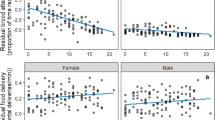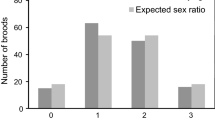Abstract
In many polygynous animals, parents invest more heavily in individual sons than in daughters. However, it is unclear if these differences in investment are a consequence of sex differences in the demand of offspring related to sexual size dimorphism or a consequence of parental manipulation. Here, we report on parental food delivery frequency in relation to brood size and brood sex ratio in a wild population of polygynous great reed warblers Acrocephalus arundinaceus. We used the polymorphic microsatellite loci on the Z chromosome to sex chicks. We found that paternal feeding frequency (times/h per nest) increased not with brood size, but with the proportion of males in the brood, although the demand per nest was more closely related to brood size than to brood sex ratio. Additionally, the increase in rate of paternal feeding frequency in relation to the brood sex ratio was much higher than the increase in rate of nestling food demands. Maternal feeding frequency was independent of both brood size and brood sex ratio. These results strongly suggest that fathers preferentially invest in their sons. We propose that parents can afford sex-biased parental care in animals in which food provisioning is enough for all offspring to survive.
Similar content being viewed by others
Author information
Authors and Affiliations
Additional information
Received: 22 January 1996/Accepted after revision: 30 June 1996
Rights and permissions
About this article
Cite this article
Nishiumi, I., Yamagishi, S., Maekawa, H. et al. Paternal expenditure is related to brood sex ratio in polygynous great reed warblers. Behav Ecol Sociobiol 39, 211–217 (1996). https://doi.org/10.1007/s002650050283
Issue Date:
DOI: https://doi.org/10.1007/s002650050283




